This African Safari Takes You on a Land Adventure and a River Cruise—Here’s What It Was Like

Safaris tend to be marketed like the movie Out of Africa, where Meryl Streep and Robert Redford, dressed in designer J. Crew khaki outfits, enjoy blissful, halcyon sunsets, surrounded by antelopes grazing on the plains and lions that occasionally hunt them, with the odd guest appearance by a zebra, elephant or hippo. The terrain is wild and dusty, with no people or shacks cluttering the panoramas.
A handful of providers still offer bona fide old-school safaris, or as close as you can get, by carefully curating privacy, luxury, and wildlife within their private reserves.
More from Robb Report
I had a very different waterborne experience in Botswana, spending a week in three Great Plains Conservation camps—the last on Sitatunga Private Island, a recently opened retreat accessible only by boat or helicopter. The first two camps, Selinda and Duba Plains, are longstanding outposts for Great Plains, which owns 15 properties across Botswana, Zimbabwe, and Kenya.

The three camps are all “open,” meaning no fences, with the number of “tents” kept purposely small to deliver on that private experience. The word “tent” is a misnomer. The multi-room suites look rustic but are designer-caliber, with stylized mosquito nets around the king-sized beds (and air-conditioning coming from the headboards), living rooms with leather couches, stocked liquor cabinets and Nespresso machines.
Beside the wood-clad showers and his-and-hers sinks are full-sized copper bathtubs, a luxury you wouldn’t expect in a remote outback (the camps run on solar power.) On the outside deck are a plunge pool and Peloton bike. A professional Canon camera is provided to document the trip.
It’s common to see elephant herds, baboons with babies clinging to them and warthog broods (it was the November birthing season) ambling 15 feet in front of the screened bedroom windows.

Selinda and Duba Plains use open Toyota Land Cruisers to reveal the wildlife across their protected lands. By contrast, Sitatunga is strictly a boating haven, located on a small lake fed by the large, slow-flowing Okavango River in the heart of northern Botswana’s Okavango Delta.
There are myriad camps in this region, but Great Plains takes great pains to create a microcosm of this part of Africa, where your group feels like Karen Blixen seeing elephants, lions, and leopards for the first time. It’s a far cry from the traffic jams of tourist buses several of our group experienced on other safaris.
On our twice-daily, three-hour drives on the bumpy, dusty trails around Selinda and Duba Plains, we encountered no other groups or, really, any signs of civilization outside the camps.

I’d come expecting a Disney experience, where the animals appear on cue. Instead, we had to search for them, including an elusive leopard keeping a wary eye on a group of baboons and two young male lions trying to take over the local Tsaro pride by killing off the lead male. (We saw the two lounging around under a tree in the hot mid-day sun, while the pride was off in another corner of the reserve.)
The week quickly took on a pleasant cadence: Breakfast, in the Land Cruiser by 6:30 to beat the unseasonably brutal heat, four hours driving on the trail, lunch, siesta, and the second jeep tour, followed by sunset cocktails (usually in the bush) and dinner at the camp.
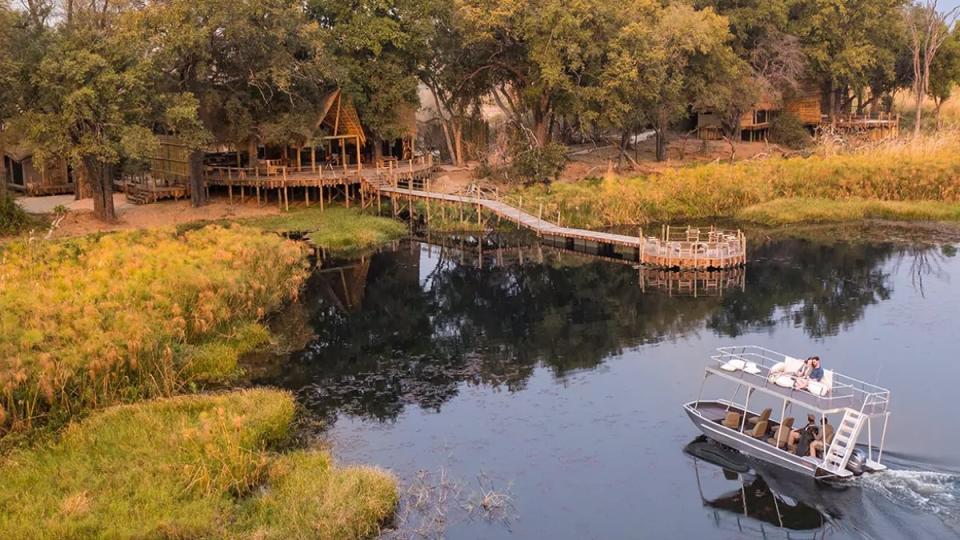
By the end of the fourth day, we’d seen 150 species of mammals and birds, an impressive bucket list for anyone who has never gone on safari. The three-hour drives covered a lot of territory—Duba Plains is 88,000 acres—and the animals generally stayed to themselves in their local habitats.
We had a Lion King moment at Duba, where a dozen species, from elephants to antelope herds to vervet monkeys to a lonesome old Cape Buffalo, grazed close to each other on a watery plain.
The highlight reel was constant, but some of the favorites included tracking the leopard off trail, a few dozen elephants trotting past us on both sides of our open vehicle, a female lion and her two cubs napping in a tree, and a comical black bird we never identified, but called “Necky,” thanks to the breakdance moves he used to seemingly romance one of our group, since there were no other female Neckys in sight.

I’d assumed the animals were tame-ish since we could get relatively close. Owner, our guide, had a more realistic theory: “If you get out of the jeep, they’ll see you as a two-legged threat, and the situation will be very different.” In other words, dangerous. The rules mandated staying seated and quiet in the vehicle and never approaching the animals on the outskirts of camp.
The first four days were about the animals, but the last three focused on the water. We arrived to Sitatunga by helicopter, a trip highlight since the pilot took a circuitous route across the ever-changing landscape, giving us a chance to see what the Kalahari desert region looks like from the air.
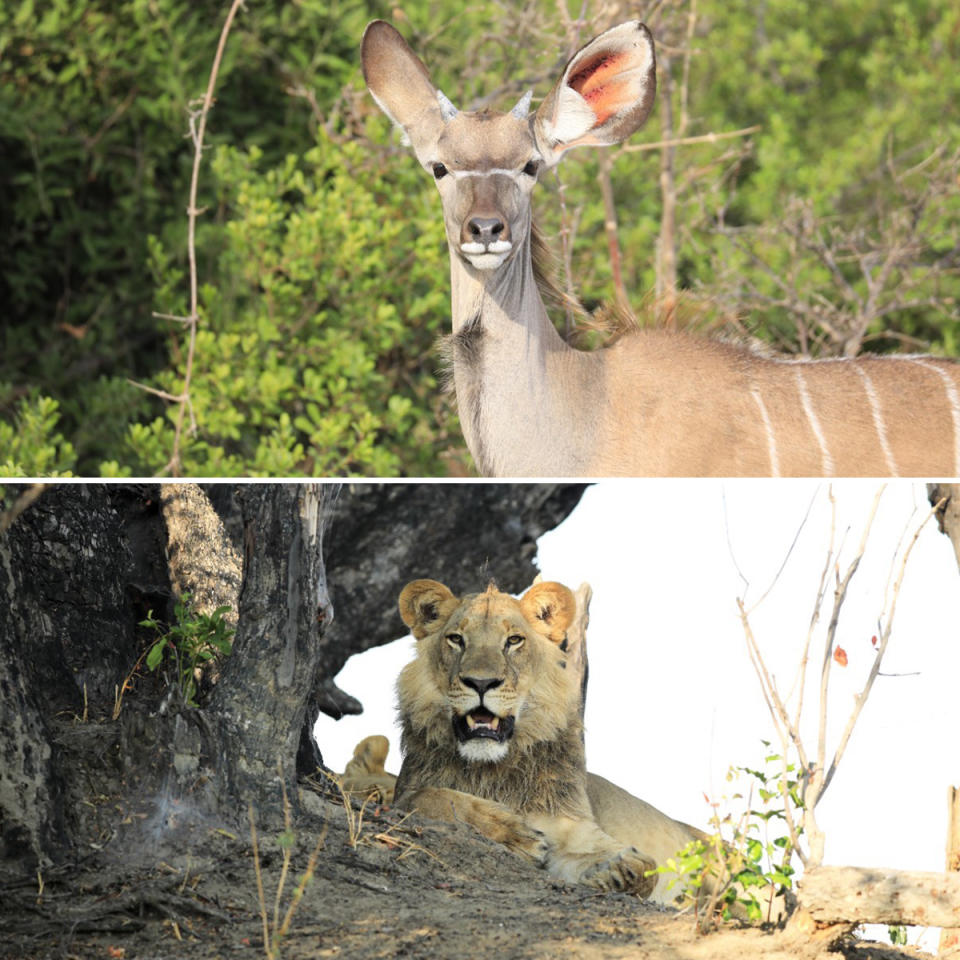
The boats at Sitatunga were a welcome change from the vehicles, partly because the heat had broken, but mostly they provided a sense of freedom that the land-based safaris couldn’t.
The camp is located on a small lake connected to the Okavango River by narrow channels. We buzzed past monster crocodiles on sandbanks, African Fish Eagles flying overhead, enjoying the cooler air as the 22-foot aluminum boat made its own air conditioning at 30 mph.
As a boater, I loved it because there were no traces of the outside world at Sitatunga—smaller and newer than the other two camps—just a family of hippos in the lake, heads above the water but keeping a good distance in their corner. The water added a layer of serenity.

Great Plains’s founders Dereck and Beverly Joubert designed Sitatunga differently than their other camps. It is smaller and more exclusive than the others, with four suites for eight people, defined by a rustic Robinson Crusoe treehouse style.
The buildings and docks were built of repurposed wood (mostly old railroad ties) and infused with character by carved Senegalese antique doors, old Persian rugs, and recycled leather couches sourced from other parts of Africa.
The Jouberts, longtime National Geographic Explorers at Large photographers and documentary filmmakers, are considered rock stars in the safari world. They’re known outside of Africa for their photography and films. But inside, they’ve established a long list of humanitarian and ecological initiatives that range from saving rhinos to creating all-female ranger groups in local communities that work on anti-poaching initiatives.
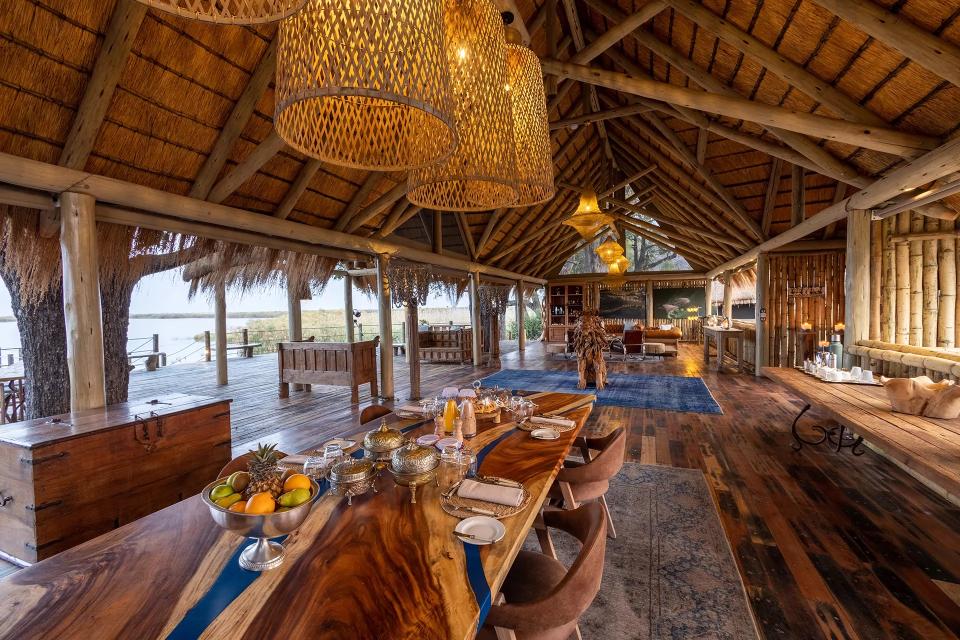
At Sitatunga, the couple wanted an indoors/outdoors feeling, designing the three A-framed suites (one is a double suite for families with an extended terrace) with large windows facing the lake, and a large dining/social hall with thatched roofs, and bamboo lampshades inspired by the woven-reed fishing baskets used by indigenous Bayei fishermen.
A life-sized wooden lion by a local artist is the centerpiece of the great hall, with a large wooden patio and deck out front to enjoy sunsets over the lake. The serene setting could’ve been out of the 1980’s movie On Golden Pond, except for the hippos in the lake.
Over the next few days, we did several trips up and down the Okavango, including a two-mile walking safari through a riverside reserve where we landed by boat. It felt so freeing to be on foot and not in a jeep. Wildlife was all around (though no big cats—a bonus for the slowest runner in our group) and the quiet landscape and immediacy of the animals made it a special experience.
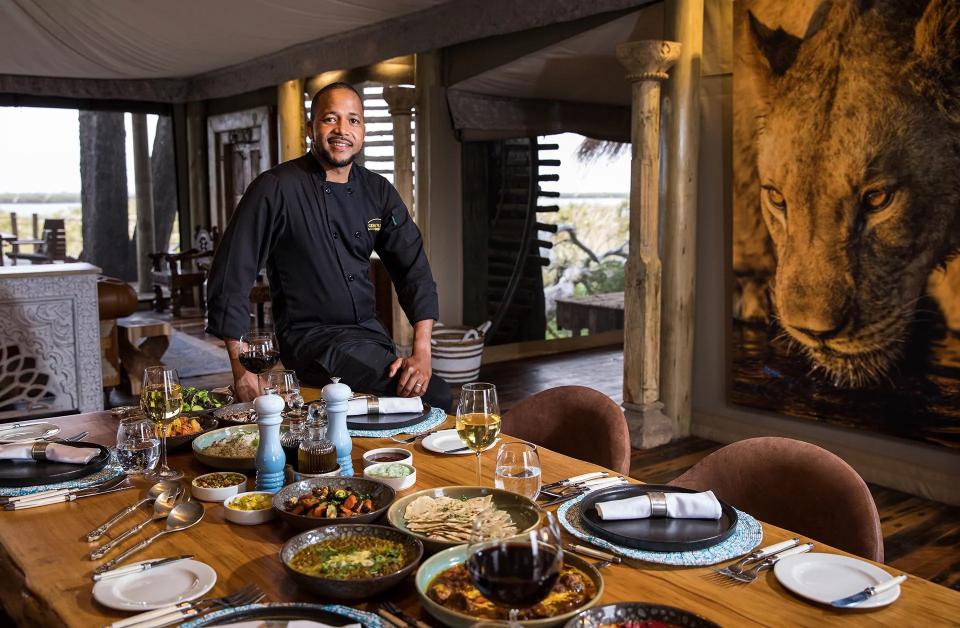
One of the high spots of the week was unexpected. I’d anticipated the cuisine would be decent with local influences, but the creative tasting menus were exceptional. They were developed for the Botswana camps by chef Kakole “Assistant” Mosiuoa, also head chef at Duba Plains. Chef K’s ever-changing menus ranged from dinners with roasted lamb to vegan options, along with creative tapas lunches (several in Duba Plains’s refrigerated wine cellar to escape the heat) along with sunset cocktails and canapes on the glowing savannah.
The apex meal was Thanksgiving dinner, where Sitatunga chef Herold Gaosikelwe served 17 Pilgrim-worthy dishes, family style, on the big dining table. They ranged from parsnip-and-sage soup to roasted chicken with cranberry stuffing, roast potatoes with pine-nut butter, pumpkin pie with a side of chocolate coffee mousse. Chef Herold even made time to whip up a delicious gluten-free chocolate cake for someone in the group who was allergic to wheat.
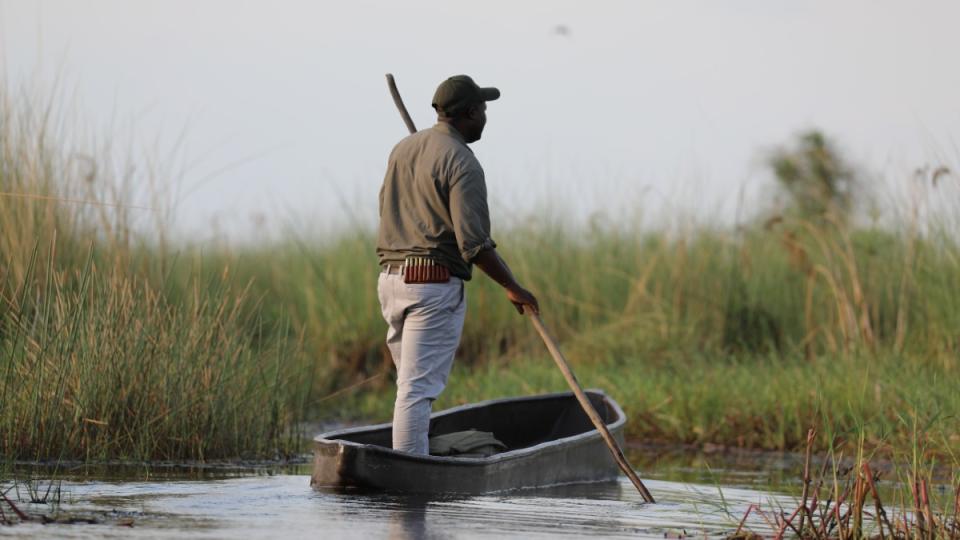
The dinner was excellent, but the real showstopper was the staff—from maids to managers—who came together at the end to serenade us with Botswanan songs and dances. They weren’t professionals, but were doing their best to ensure we had a Thanksgiving we’d always remember.
Our group, consisting mostly of veteran travel writers, agreed the staff at all the camps were unusual, even among five-star resorts. Their warmth was genuine, the kind that can’t be faked, and they took pride in making sure the stay was a bucket-lister. The best example was when Lizzy Bayani, the manager who accompanied us, brought a hot-water foot bath by helicopter for one of our party whose ankles had swollen in the heat.
While the week had its oohs and ahs, and lots of laughs at meals, the climax came the day before departure. Our ride in the mokoros, the local version of a dugout canoe, was supposed to be the “relaxing” grand finale. But our first view was a bull elephant mounting a female—a sight so rare that, among the three guides, only the leader, Letty, had ever seen it.
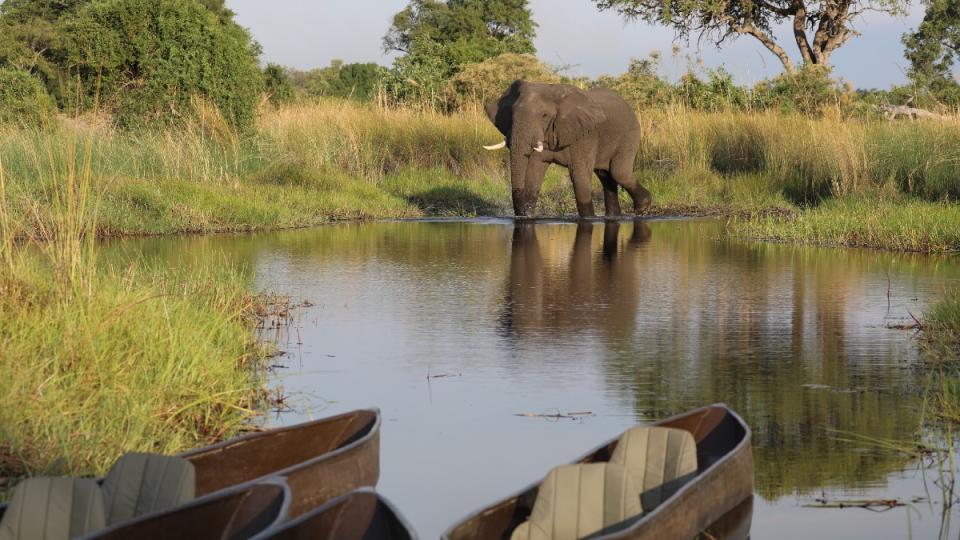
The bull didn’t take kindly to camera-clicking, two-legged gawkers and went into anger mode. He didn’t charge but was clearly ready. He got so worked up, in fact, that Letty directed us from the canoes to the jeep. Another guide muttered we’d be cursed after seeing the mating ritual.
Turns out he was right. The elephants eventually ambled away into the bush and then the guides pushed us, gondola-style, into knee-deep, three-foot-wide channels lined by Papyrus reeds. But when we emerged onto the river, we startled a bloat of hippos. With adults weighing as much as 4,000 pounds, hippos aren’t always the lumbering gentle giants in children’s books, especially when they feel threatened. Rather than waiting for trouble, the lead male goes on the attack.
It’s possible in the low canoes, the big bull mistook us for a crocodile. It didn’t matter. Just 20 yards away, it first made warning noises, opening its muscular jaws to a wide, head-crunching circumference, then disappeared under water, surfacing closer to us. It’s one thing to be in a powerboat where you can push the throttle and speed away. It’s another to be a sitting duck in three feet of water, with nothing but a guide pushing you with a pole.
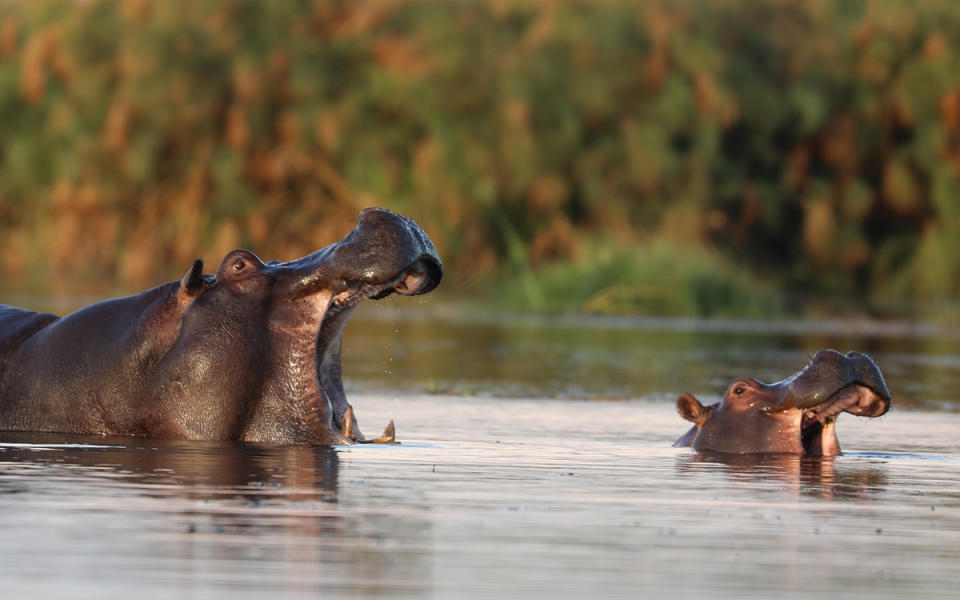
That was the only time the trip could’ve gone sideways. It didn’t, but the hippo was so incensed it followed us up into the channel, as the guides fast-poled back to the jeeps. Nobody felt like a casual observer after that close encounter, and one of the group was so pumped with adrenaline she was trembling. Still, what a great “Out of Africa” way to end the week.
Looking back, doing the three camps, with Sitatunga at the end, made the most sense, since the first two provided intensive animal exposure, while the last was more about seeing the area by water.
For those interested, we booked through Premier Tours (800-545-1910) in Philadelphia, which has specialized in organizing African safaris and trips to other remote parts of the world for more than 20 years. The cost during the dry season (low season) was $13,690 per person, including all internal flights and the helicopter trips to and from the camps. Roundtrip flights to Maun, the gateway into Botswana, were not included.
Best of Robb Report
Sign up for Robb Report's Newsletter. For the latest news, follow us on Facebook, Twitter, and Instagram.


